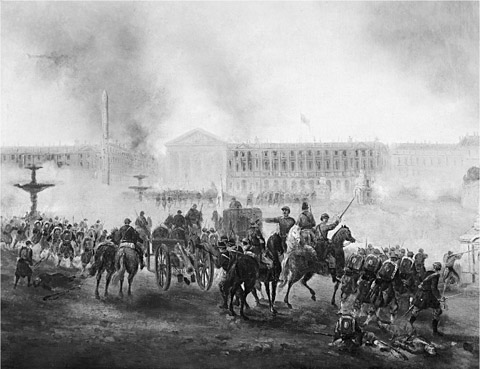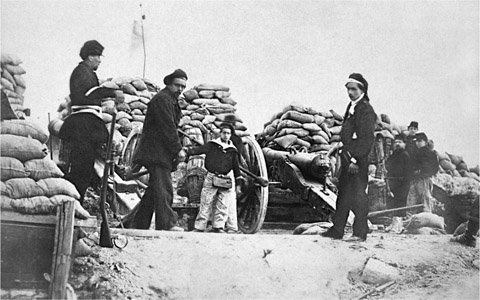Massacre
Authors: John M. Merriman




Copyright © 2014 John Merriman
Published with assistance from the Kingsley Trust Association Publication Fund established by the Scroll and Key Society of Yale College.
All rights reserved. This book may not be reproduced in whole or in part, in any form (beyond that copying permitted by Sections 107 and 108 of the U.S. Copyright Law and except by reviewers for the public press) without written permission from the publishers.
For information about this and other Yale University Press publications, please contact:
U.S. Office:
[email protected]
www.yalebooks.com
Europe Office:
[email protected]
www.yalebooks.co.uk
Typeset in Adobe Caslon Pro by IDSUK (DataConnection) Ltd
Printed in Great Britain by TJ International Ltd, Padstow, Cornwall
Library of Congress Cataloging-in-Publication Data
Merriman, John M.
Massacre : the life and death of the Paris Commune of 1871 / John Merriman.
pages cm
Includes bibliographical references and index.
ISBN 978-0-300-17452-6 (alk. paper)
1. Paris (France)—History—Commune, 1871. I. Title. II. Title: Life and death of the Paris Commune of 1871.
DC316.M47 2014
944′.3610812—dc23
2014027077
A catalogue record for this book is available from the British Library.
10 9 8 7 6 5 4 3 2 1
For Don Lamm
Contents
1
War and the Collapse of the Empire
5
The Battle Turns Against the Communards
7
Death Comes for the Archbishop
Acknowledgements
A
S LONG AS
I
REMEMBER
, I
HAVE BEEN FASCINATED BY THE
P
ARIS
Commune of 1871. My previous book was a study that focused on Émile Henry, a young intellectual and anarchist who threw a bomb into the Café Terminus near the Gare Saint-Lazare in the French capital in February 1894. His goal was to kill as many people as possible. Henry’s targets were ordinary bourgeois having a beer and listening to music before they returned home. My argument was that Henry’s bomb represented the origins of modern terrorism. But there was a subtext: that of state terrorism. The French state, like that of Italy and Spain, used the fear of anarchists – and most anarchists were not terrorists at all – to repress political opponents. Émile Henry was the son of a militant in the Paris Commune of 1871, condemned to death in absentia by the French provisional government of Adolphe Thiers. Fortuné Henry had seen state terrorism up close. Soldiers fighting for the government of Versailles gunned down or executed thousands of ordinary people.
About six or seven years ago, the Bibliothèque historique de la ville de Paris organised an exposition of photos taken during the Franco-Prussian War of 1870–71 (in which Prussia and its other German allies crushed the Second Empire of Napoleon III) and during the Commune. One of these photos stuck in my mind: that of elegant upper-class Parisians returning to the French capital after their armies had crushed the Paris Commune during Bloody Week, 21–28 May 1871. They applauded the terror organised by the French state, which had crushed Parisians who wanted to be free.
One day, while walking to my office in Branford College at Yale, I decided to research and write a book about the life and death of the Paris
Commune, focusing on the representative experiences of Communards, but also some of those who opposed them.
The MacMillan Center and the Whitney Griswold Fund at Yale University offered research support for this book. Bertrand Fonck, with whom Caroline Piketty put me in touch, made it possible for me access dossiers in the Archives de la Défense in Vincennes when they were otherwise unavailable.
Writing about the Paris Commune of 1871, I have benefited greatly from the important studies of Laure Godineau, Éric Fournier, Carolyn Eichner, David Shafer, Gay Gullickson, Quentin Deleurmoz, Marc César and Stewart Edwards. I have long admired and in particular learned from the superb scholarship of Robert Tombs and Jacques Rougerie, essential for anyone interested in the Commune. Tom Kselman, Colin Foss and Joe Peterson also offered suggestions drawn from their knowledge of the period. Thanks also to someone I have never met, Olivier Marion, whose fine unpublished
mémoire de maîtrise
on the Catholic Church during the Commune (available in the Archives Départementales des Hauts-de-Seine) merits wider exposure. In Fayl-Billot, Haute-Marne, where Archbishop Georges Darboy was born, I would like to thank Philippe Robert, until recently
curé
of that parish, and Jean-Remy Compain.
I was incredibly fortunate at the University of Michigan to have had the chance to study with Charles Tilly, who directed my dissertation long ago, and to have had him as a friend. As is the case of so many people in many fields, Chuck’s death in 2008 remains an enormous loss.
Pour leur amitié et la manière dont ils ont inspiré mes travaux, je tiens à remercier chaleureusement
Michelle Perrot, Alain Corbin, Jean-François Chanet, Dominique Kalifa, Sylvain Venayre, Maurice Garden and Yves Lequin. If the research for this book took place in Paris, most of it was written in Balazuc (Ardèche). There I am fortunate to have as friends Lucien and Catherine Mollier, Hervé and Françoise Parain, Eric Fruleux and Mathieu Fruleux. Thanks also there to William Clavaroyet of ‘La Fenière’ and Lionel Pélerin of ‘Chez Paulette’, and to Paulette Balazuc. In Poland, where I have had the pleasure of spending a great amount of time over the past eight years, thanks to Andrzej Kamiński, Wojciech Falkowski, Krzysztof Łazarski, Adam Kożuchowski and Eulalia Łazarska, as well as Jim Collins; in Rouen, to Jean Sion; in Paris, to Jean-Claude Petilon and Sven Wanegffelen; in the United States, to Bruno and Flora Cabanes, Charles Keith, Mark Lawrence, Gene Tempest, Joe Malloure, Jim Read, Steve Shirley, Gil Joseph, Dick and Sandy Simon, Mike Johnson, Steve Pincus, Sue Stokes and Peter Gay. Our family owes Victoria Johnson so much.
Peter McPhee and I have been talking about French history and much more since we first met in 1974 –
ça passe vite, le temps
. He read the first draft of this book and offered his usual extremely helpful comments. At the Fletcher Company, I am indebted to Christy Fletcher and Melissa Chincillo, and to Donald Lamm, who has supported this project from the beginning. Again, Don contributed his unparalleled editing skills to one of my books. Melissa, with the assistance of Anne van den Heuvel, obtained the publication rights for the images in the book, greatly helping out in a complex eleventh hour. At Yale University Press, London, many thanks to Robert Baldock, director, and to Rachael Lonsdale, editor, for their encouragement and good cheer.
Laura Merriman has spent much of her life in France, in Balazuc, but is often in Paris, where this tragic story took place. Chris Merriman first arrived in Balazuc at the age of ten days, and was able to spend years in school in France, and thus also knows Paris very well. My spouse Carol Merriman contributed her editing skills to this book and has brought so much happiness into my life, including Laura and Chris.
Donald and Jean Lamm have been our friends for decades. Don has always represented the very best in publishing. This book is dedicated to him in gratitude and friendship and with great admiration.
Balazuc, 7 June 2014



1 The Army of Versailles battling Communard resisters on place de la Concorde, 22 May 1871, by Gustave Boulanger.

